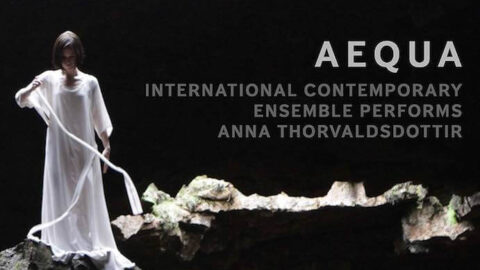In recent years, the environment and humankind’s ecological impact have been a frequent subject in contemporary art music. John Luther Adam’s In the Name of the Earth (2017) delivers a cautionary, yet hopeful prayer for the future. Ashley Fure’s The Force of Things: An Opera for Objects (2017) powerfully evokes “ecological anxiety.” In this milieu, Anna Thorvaldsdottir possesses a uniquely powerful compositional voice that synthesizes ecological processes and structures into cohesive, yet timbrally detailed pieces. On her latest release, AEQUA (2018, Sono Luminus), Anna curates solo and chamber works that were loosely and directly inspired by, “various states of balancing forces–by the natural breath and expansion and contraction, and the perspectives of translucence and opacity.” Sensitively interpreted by the musicians of the International Contemporary Ensemble (ICE), these works coalesce to form a remarkably engaging musical journey through soundscapes that are, quite simply, breathtaking.
The lead track Scape (2011), for prepared piano, develops out of the placid resonance of a solitary note. Amidst this ethereal soundscape, wandering chromatic melodic lines filigreed with metallic sounds emerge. Anna continuously develops each of these element throughout the work. Accented notes transform into forceful pizzicato. Chromatic melodies are transposed to the lowest registers of the piano, resulting in a deep, expansive texture. The final return to the opening resonance is transposed to a persistent, slowly decaying upper harmonic of the opening resonance. In his performance, Cory Smythe achieves a gripping pacing through subtle rubato, attention to the shape of each sound, and masterful transitions between the various effects.

Spectra (2017), one of two works for violin, viola, and cello on the album, begins with a similar resonance and develops many of the same sounds and gestures as Scape. Any compositional similarities–that are in fact common to many of the works found AEQUA–are merely superficial. New melodic and timbral material develops from and returns to a single cello note, cascading through undulating waves of tremolos, crescendos, glissandi, and percussive effects in the process. An arresting departure from this developmental process introduces wispy harmonics and tremolos that could be mistaken for air sounds on any woodwind instrument. Reflections (2016), the penultimate work on the album for the same instrumentation, demonstrates the ecological diversity of Anna’s soundscapes and compositional techniques. The musical material found in Spectra develops into a steady, measured progression through fragile, yet radiant gestures that swirl across the soundscape, totally surrounding the listener.
Steve Schick masterfully leads ICE through AEQUA’s larger works including Aequilibria (2014) for mixed chamber ensemble, and Illumine (2016) for string octet. As the album’s focal point, Aequilibria cultivates vast, fluidly developing soundscapes using Anna’s signature approach to large ensemble orchestration. Previously serene resonance now pulsates with multiple timbres and dynamic swells. Flurries of melodic fragments are timbrally varied as they are passed quickly between instrumental families. Illumine achieves a similar effect with a radically different ensemble instrumentation, a testament to Anna and Schick’s imagination and keen attention to detail. As a result, the attentive listener is rewarded with carefully prepared moments of consonances and dissonances, delicately placed within Illumine’s placid textures.
Sequences (2016) features Isabel Gleicher (bass flute) Campbell MacDonald (bass clarinet), Ryan Muncy (baritone saxophone), and Rebekah Heller’s (contra-bassoon) collective, virtuosic explorations of the lowest, breathy, groaning, sonic gesticulations capable on their respective instruments. The continuous development and seamless blending of each of these diverse sounds creates a dark and tempestuous texture unique among Anna’s output. This superlative performance is further enhanced by Daniel Power’s mixing. Each utterance is carefully spatialized to create a dizzyingly, yet satisfyingly immersive soundscape. This attention to detail and fidelity of sound highlights the unique textures and timbres found in each of Anna’s compositions, creating the sensation of listening to each piece from a slightly different perspective.

Fields (2016) functions as a meditative, total synthesis of the works on the album. Previous musical material is rendered as a repeating cell, slowly passed between instruments. This juxtaposition of material gives the listener time to process each sound and reflect on how its meaning has changed over the album. These cells gradually cease to repeat, giving way to gentle air sounds, overpressure bowing, and harmonics. Nested within this, and only briefly audible, is a grand poetic echo–the resonance from a single note on the piano.
The depth of the relationship between ICE, Anna, and Schick is sonically palpable through the generous and nuanced performances found on AEQUA. The result is an outstandingly rich album that invites rather than demands open and deep listening. Given Anna’s sources of aesthetic inspiration, this invitation likely extends to the ecology of the natural and human world around us. In the tumult of the current environmental, social, and political climate, AEQUA creates a much needed space to revisit the art and practice of listening.
























